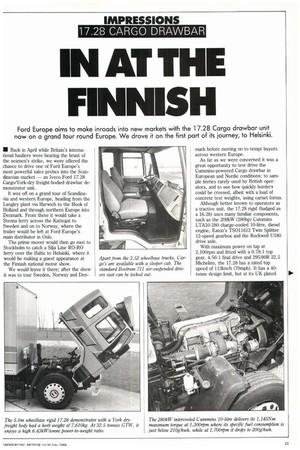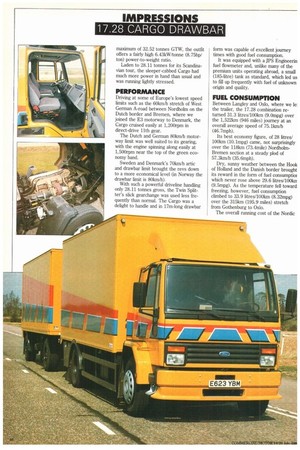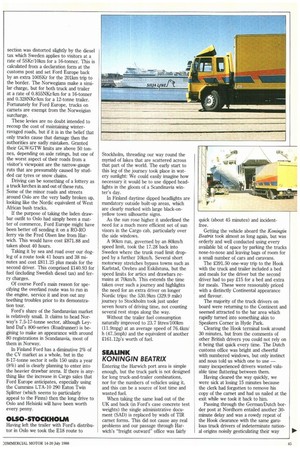IN AT THE FINNISH
Page 33

Page 34

Page 35

Page 36

If you've noticed an error in this article please click here to report it so we can fix it.
• Back in April while Britain's international hauliers were bearing the brunt of the seamen's strike, we were offered the chance to drive one of Ford Europe's most powerful sales probes into the Scandinavian market — an lveco Ford 17.28 Cargo/York-dry freight-bodied drawbar demonstrator unit.
It was off on a grand tour of Scandinavia and western Europe, heading from the Langley plant via Harwich to the Hook of Holland and through northern Europe into Denmark. From there it would take a Stemia ferry across the Kattegat to Sweden and on to Norway, where the trailer would be left at Ford Europe's main distributor in Oslo.
The prime mover would then go east to Stockholm to catch a Silja Line RID-RC) ferry over the Baltic to Helsinki, where it would be making a guest appearance at the Finnish national motor show.
We would leave it there; after the show it was to tour Sweden, Norway and Den mark before moving on to tempt buyers across western Europe.
As far as we were concerned it was a great opportunity to test drive the Cummins-powered Cargo drawbar in European and Nordic conditions; to sample ferries rarely used by British operators, and to see how 'wieldy borders could be crossed, albeit with a load of concrete test weights, using carnet forrns.
Although better known to operators as a tractive unit, the 17.28 rigid (badged as a 16.28) uses many familiar components, such as the 209kW (280hp) Cummins LTA10-280 charge-cooled 10-litre, diesel engine, Eaton's TS011612 Twin Splitter 12-speed gearbox and the Rockwell U180 drive axle.
With maximum power on tap at 2,100rpm and fitted with a 0.78:1 top gear, 4.56:1 final drive and 295/80R 22.5 Michelins, the 17.28 has a rated top speed of 113km/h (70mph). It has a 40tonne design limit, but at its UK plated
maximum of 32.52 tonnes GTW, the outfit offers a fairly high 6.43kW/tonne (8.75hp/ ton) power-to-weight ratio.
Laden to 28.11 tonnes for its Scandinavian tour, the sleeper-cabbed Cargo had much more power in hand than usual and was running lightly stressed.
PERFORMANCE
Driving at some of Europe's lowest speed limits such as the 601cm/h stretch of West German A-road between Nordholm on the Dutch border and Bremen, where we joined the E3 motorway to Denmark, the Cargo cruised easily at 1,200rpm in direct-drive 11th gear.
The Dutch and German 801cm/h motorway limit was well suited to its gearing, with the engine spinning along easily at 1,500rpm near the top of the green economy band.
Sweden and Denmark's 70km/h artic and drawbar limit brought the revs down to a more economical level (in Norway the drawbar limit is 80km/h).
With such a powerful driveline handling only 2831 tonnes gross, the Twin Splitter's slick gearchange was used less frequently than normal. The Cargo was a delight to handle and in 17m-long drawbar form was capable of excellent journey times with good fuel consumption.
It was equipped with a JPS Engineerin fuel flowmeter and, unlike many of the premium units operating abroad, a small (185-litre) tank as standard, which led us to fill up frequently with fuel of unknown origin and quality.
FUEL CONSUMPTION
Between Langley and Oslo, where we le: the trailer, the 17.28 combination returned 31.3 litres/100km (9.0mpg) over the 1,5221cm (946 miles) journey at an overall average speed of 75.1Iun/h (46. 7mph).
Its best economy figure, of 28 litres/ 100Iun (10.1mpg) came, not surprisingly over the 118km (73.4mile) NordholmBremen section at a steady plod of 57.3Icm/h (35.6mph).
Dry, sunny weather between the Hook of Holland and the Danish border brought its reward in the form of fuel consumptior which never rose above 29.6 litres/100krr (9.5mpg). As the temperature fell toward freezing, however, fuel consumption climbed to 33.9 litres/100km (8.32mpg) over the 315km (195.9 miles) stretch from Gothenburg to Oslo.
The overall running cost of the Nordic
section was distorted slightly by the diesel tax which Sweden applies to visitors at a rate of 5SKr/101un for a 16-tonner. This is calculated from a declaration form at the customs post and set Ford Europe back by an extra 100Slir for the 201km trip to the border. The Norwegians make a similar charge, but for both truck and trailer at a rate of 0.855NI{r/lun for a 16-tonner and 0.328NI{r/km for a 12-tonne trailer. Fortunately for Ford Europe, trucks on carnets are exempt from the Norweigian surcharge.
These levies are no doubt intended to recoup the cost of maintaining winterravaged roads, but if it is in the belief that only trucks cause that damage then the authorities are sadly mistaken. Granted their GCW/GTW limits are above 50 tonnes, depending on axle ratings, but one of the worst aspect of their roads from a visitor's viewpoint are the narrow-gauge ruts that are presumably caused by studded car tyres or snow chains.
Driving can be something of a lottery as a truck lurches in and out of these ruts. Some of the minor roads and streets around Oslo are the very badly broken up, looking like the Nordic equivalent of West African bush tracks.
If the purpose of taking the laden drawbar outfit to Oslo had simply been a matter of commerce, Ford Europe might have been better off sending it on a RO-RO ferry via the Fred Olsen line from Harwich. This would have cost 2871.88 and taken about 40 hours.
Taking it by sea and road over our dogleg of a route took 41 hours and 38 minutes and cost 2811.25 plus meals for the second driver. This comprised 2140.93 for fuel (including Swedish diesel tax) and ferry charges.
Of course Ford's main reason for specifying the overland route was to run in the engine, service it and iron out any teething troubles prior to its demonstration tour.
Ford's share of the Sandanavian market is relatively small. It claims to head Norway's 7.5-17-tonne sector, although Leyland Dafs 800-series (Roadrunner) is begining to make an appearance with around 80 registrations in Scandanavia, most of them in Norway.
In Finland Ford has a diminutive 2% of the CV market as a whole, but in the 8-17-tonne sector it sells 150 units a year (8%) and is clearly planning to enter into the heavier drawbar arena. If there is anything like the increase in Cargo sales that Ford Europe anticipates, especially using the Cummins LTA-10 290 Eaton Twin Splitter (which seems to particularly appeal to the Finns) then the long drive to Oslo and Helsinki will have been worth every penny.
OLSO-STOCKHOLM
Having left the trailer with Ford's distributor in Oslo we took the E18 route to Stockholm, threading our way round the myriad of lakes that are scattered across that part of the world. The early start to this leg of the journey took place in watery sunlight: We could easily imagine how necessary it would be to use dipped headlights in the gloom of a Scandinavia winter's day.
In Finland daytime dipped headlights are mandatory outside built-up areas, which are clearly marked with large black-onyellow town silhouette signs.
As the sun rose higher it underlined the need for a much more efficient set of sun visors in the Cargo cab, particularly over the side windows.
A 90km run, governed by an 80km/h speed limit, took the 17,28 back into Sweden where the trunk road limit dropped by a further 101unfh. Several short motorway stretches bypass towns such as Karlstad, Orebro and Eskilstuna, but the speed limits for artics and drawbars remains at 701m/h. This extends the time taken over such a journey and highlights the need for an extra driver on longer Nordic trips: the 530.91un (329.9 mile) journey to Stockholm took just under seven hours of driving time, not counting several rest stops along the way.
Without the trailer fuel consumption naturally improved to 23.7 litres/100km (11.9mpg) at an average speed of 76.4km/ h (47.5mph) and the equivalent of another 2161.12p's worth of fuel.
SEALINK KONING1N BEATR1X
Entering the Harwich port area is simple enough, but the truck park is not designed for long truck-and-trailer combinations, nor for the numbers of vehicles using it, and this can be a source of lost time and wasted fuel.
When taking the same load out of the UK and back (in Ford's case concrete test weights) the single administrative document (SAD) is replaced by wads of TIR carnet forms. This did not cause any real problems and our passage through Harwich's "freight outward" office was fairly quick (about 45 minutes) and incidentfree.
Getting the vehicle aboard the Koningin Beatrix took almost as long again, but was orderly and well conducted using every available bit of space by parking the trucks nose-to-nose and leaving bags of room for a small number of cars and caravans.
The 2391.50 one-way trip to the Hook with the truck and trailer included a bed and meals for the driver but the second driver had to pay 215 for a bed and extra for meals. These were reasonably priced with a distinctly Continental appearance and flavour.
The majority of the truck drivers on board were returning to the Continent and seemed attracted to the bar area which rapidly turned into something akin to Speakers Corner in Hyde Park.
Clearing the Hook terminal took around 30 minutes, but from the comments of other British drivers you could not rely on it being that quick every time. The Dutch customs office was bright and cheerful with numbered windows, but only instinct and nous told us which one to use — many inexperienced drivers wasted valuable time fluttering between them.
Having cleared the way quickly, we were sick at losing 15 minutes because the clerk had forgotten to remove his copy of the carnet and had us nailed at the exit while we took it back to him.
Passing through the German/Dutch border post at Nordhorn entailed another 30minute delay and was a rowdy repeat of the Hook clearance with the same garulous truck drivers of indeterminate national origins noisily gesticulating their way through the checkpoint.
Negotiating the Padborg crossing to Denmark was much more sedate, with the efficient German clerks correcting a couple of ommissions on the carnets without any fuss and making up for the disdain shown in their banks for our pound coins.
The Danish office, with its wall of dispatch boxes for company and driver use, seemed equally efficient but a little more relaxed. Despite the air of quiet competence, however, the crossing into Denmark took 97 minutes. With our driving hours about to run out we made our overnight stop on terra firma, setting off early next morning to catch the afternoon ferry from Frederikshaven in northern Jutland to Gothenburg.
STENA LINE:
MIV STENA JUTLANDICA
The small numbers of British trucks travelling on the jutlandica would seem a fair indication of the state of our export industry. Apart from ourselves, the only UK trucks using it were carrying equipment for a pop concert in the USSR.
Apart from a brief debate about harbour fees of 160Skr (215.22) which had not been mentioned when we booked the journey, port clearance was hassle-free and took a leisurely 45 minutes. Being mid-week the ship was only partly filled so boarding was quick and easy.
The one-way trip for a truck, trailer and driver cost 2,830Skr (2269.27) plus another 80Skt(27.61) for the second driver.
Stena's Jutlandica is similar in specification and fittings to the Beatrix but there the resemblance ended. The driver received a 25Skr (22.38) refund in the restaurant or cafetieria and enjoyed a cabin with a comfortable bunk, shower and toilet.
The ferry exuded a quiet, peaceful atmoshphere that made a pleasant change from the vulgar burly-burly of the Channel ferries, and once into Gothenburg the ship was vacated in an orderly, well-behaved manner.
Both Sweden and Norway have adopted the common transit procedure that applies in EEC and EFTA countries, so the SAD form is used there for exports, imports and trans-Nordic movements. For the Cargo 17.28 drawbar and its concrete "nuggets" the carnet rule was also acceptable. Being asked to prove ownership could be embarrassing so with this in mind the Ford Europe representative carried an impressive A4-size V379 certificate of registration which can be issued by Swansea on request.
With only a handful of drivers seeking clearance the Cargo drawbar was back on the road within 35 minutes and heading along the E6 for the Norwegian border at picturesque Svinesund, where the Lommelanda fliord meets the Skagerakand. The bridge there is the sort of place that delays should occur if anywhere, but evidently they seldom do.
Here, and at the more northerly border crossing near Orje, customs procedures were much less formal than others we had encountered on the trip: the officials seemed intent on hastening drivers on their way.
SIUA LINE: MS FINLANDIA
In spite of the Swedes' impeccable behaviour, Stockholm at 5:30pm is no different from any major city, with whiteand blue-collar workers making their Kamikazi runs for home. At that time its traffic routeing is a nightmare for heavy trucks, taking them a long way round the city and crossing several major roads en route to the docks.
Customs clearance took little more than an hour, and parking on the Finlandia's lower deck was even quicker.
If the jutlandka was a quiet, comfortable ferry, then the immaculate Finlandia pride of Silja's "white" fleet — could only be described as a cruise liner of a ferry. Against the Beatrix, it is like comparing Stefan Edberg with Boris Becker.
Its six restaurants offered a wide choice of food and entertainment for up to 2,000 people, while up to 70 truck drivers could be catered for in a seperate area. This was no works canteen, either, with four choices of fish or meat plus a cold meat salad and a Continental breakfast.
Included in the 2,726Skr (U47.14) charged for carryng the Cargo 17.28 rigid to Helsinki the two drivers had separate rooms with showers and toilets. A sauna room with soap, shampoo and towels added that final Scandinavian touch.














































